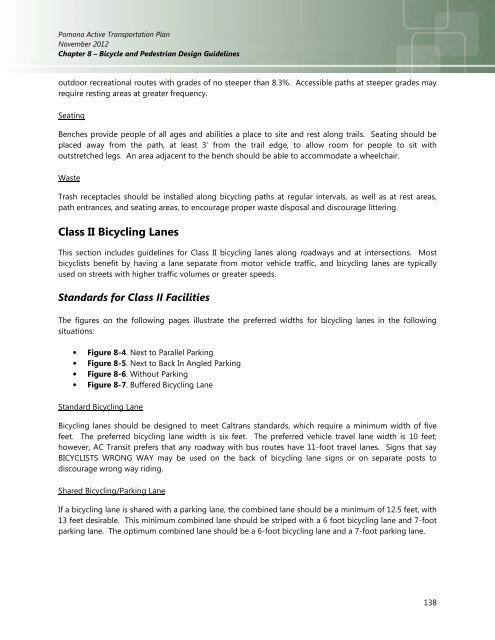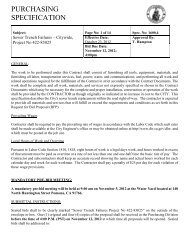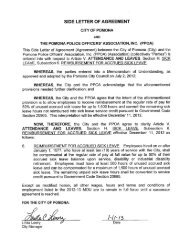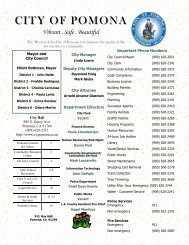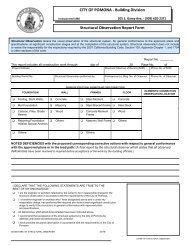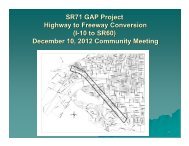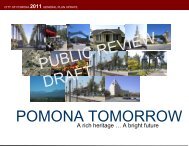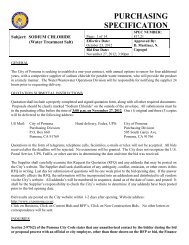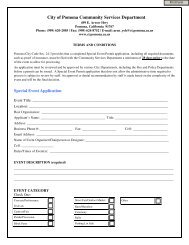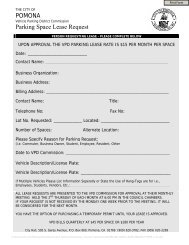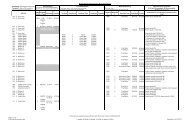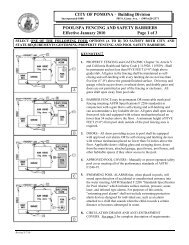- Page 1 and 2:
“ACTIVE TRANSPORTATION PLAN: Bicy
- Page 4 and 5:
APPENDICES Appendix A: Public Input
- Page 6 and 7:
LIST OF EXHIBITS Exhibit 7-1 - San
- Page 8 and 9:
Pomona Active Transportation Plan N
- Page 10 and 11:
Pomona Active Transportation Plan N
- Page 12 and 13:
Pomona Active Transportation Plan N
- Page 14 and 15:
Pomona Active Transportation Plan N
- Page 16 and 17:
Pomona Active Transportation Plan N
- Page 18 and 19:
Pomona Active Transportation Plan N
- Page 20 and 21:
Pomona Active Transportation Plan N
- Page 22 and 23:
Pomona Active Transportation Plan N
- Page 24 and 25:
Pomona Active Transportation Plan N
- Page 26 and 27:
Pomona Active Transportation Plan N
- Page 28 and 29:
Pomona Active Transportation Plan N
- Page 30 and 31:
Pomona Active Transportation Plan N
- Page 32 and 33:
Pomona Active Transportation Plan N
- Page 34 and 35:
Pomona Active Transportation Plan N
- Page 36 and 37:
Bonita Ave D i San Dimas Ave San Di
- Page 38 and 39:
Pomona Active Transportation Plan N
- Page 40 and 41:
Pomona Active Transportation Plan N
- Page 42 and 43:
Pomona Active Transportation Plan N
- Page 44 and 45:
Pomona Active Transportation Plan N
- Page 46 and 47:
Pomona Active Transportation Plan N
- Page 48 and 49:
Pomona Active Transportation Plan N
- Page 50 and 51:
Pomona Active Transportation Plan N
- Page 52 and 53:
Bonita Ave D i San Dimas Ave San Di
- Page 54 and 55:
Pomona Active Transportation Plan N
- Page 56 and 57:
Pomona Active Transportation Plan N
- Page 58 and 59:
Pomona Active Transportation Plan N
- Page 60 and 61:
Pomona Active Transportation Plan N
- Page 62 and 63:
TABLE 4.2 - PROPOSED PROJECT LIST F
- Page 64 and 65:
Bonita Ave Indian Hill Blvd Arrow R
- Page 66 and 67:
Pomona Active Transportation Plan N
- Page 68 and 69:
Pomona Active Transportation Plan N
- Page 70 and 71:
Pomona Active Transportation Plan N
- Page 72 and 73:
Pomona Active Transportation Plan N
- Page 74 and 75:
Pomona Active Transportation Plan N
- Page 76 and 77:
Pomona Active Transportation Plan N
- Page 78 and 79:
Pomona Active Transportation Plan N
- Page 80 and 81:
Pomona Active Transportation Plan N
- Page 82 and 83:
Pomona Active Transportation Plan N
- Page 84 and 85:
Pomona Active Transportation Plan N
- Page 86 and 87:
Pomona Active Transportation Plan N
- Page 88 and 89:
Pomona Active Transportation Plan N
- Page 90 and 91:
Pomona Active Transportation Plan N
- Page 92 and 93:
Pomona Active Transportation Plan N
- Page 94 and 95: Pomona Active Transportation Plan N
- Page 96 and 97: Pomona Active Transportation Plan N
- Page 98 and 99: Pomona Active Transportation Plan N
- Page 100 and 101: Pomona Active Transportation Plan N
- Page 102 and 103: Pomona Active Transportation Plan N
- Page 104 and 105: Pomona Active Transportation Plan N
- Page 106 and 107: Pomona Active Transportation Plan N
- Page 108 and 109: Pomona Active Transportation Plan N
- Page 110 and 111: Pomona Active Transportation Plan N
- Page 112 and 113: Pomona Active Transportation Plan N
- Page 114 and 115: Pomona Active Transportation Plan N
- Page 116 and 117: Pomona Active Transportation Plan N
- Page 118 and 119: Pomona Active Transportation Plan N
- Page 120 and 121: Pomona Active Transportation Plan N
- Page 122 and 123: Pomona Active Transportation Plan N
- Page 124 and 125: TABLE 7.2 - BICYCLE FACILITY PHASIN
- Page 126 and 127: Exhibit 7-1 - San Antonio Avenue Bi
- Page 128 and 129: Exhibit 7-2 - San Jose Creek Bicycl
- Page 130 and 131: Exhibit 7-3 - Park Avenue Bicycle L
- Page 132 and 133: Exhibit 7-4 - Monterey Avenue Bicyc
- Page 134 and 135: Exhibit 7-5 - Garey Avenue Bicycle
- Page 136 and 137: Pomona Active Transportation Plan N
- Page 138 and 139: Pomona Active Transportation Plan N
- Page 140 and 141: Pomona Active Transportation Plan N
- Page 142 and 143: Pomona Active Transportation Plan N
- Page 146 and 147: Pomona Active Transportation Plan N
- Page 148 and 149: Pomona Active Transportation Plan N
- Page 150 and 151: Pomona Active Transportation Plan N
- Page 152 and 153: Pomona Active Transportation Plan N
- Page 154 and 155: Pomona Active Transportation Plan N
- Page 156 and 157: Pomona Active Transportation Plan N
- Page 158 and 159: Pomona Active Transportation Plan N
- Page 160 and 161: Pomona Active Transportation Plan N
- Page 162 and 163: Pomona Active Transportation Plan N
- Page 164 and 165: Pomona Active Transportation Plan N
- Page 166 and 167: Pomona Active Transportation Plan N
- Page 168 and 169: Pomona Active Transportation Plan N
- Page 170 and 171: Pomona Active Transportation Plan N
- Page 172 and 173: Pomona Active Transportation Plan N
- Page 174 and 175: Pomona Active Transportation Plan N
- Page 176 and 177: Pomona Active Transportation Plan N
- Page 178 and 179: Pomona Active Transportation Plan N
- Page 180 and 181: Pomona Active Transportation Plan N
- Page 182 and 183: Pomona Active Transportation Plan N
- Page 184 and 185: Pomona Active Transportation Plan N
- Page 186 and 187: Pomona Active Transportation Plan N
- Page 188 and 189: Pomona Active Transportation Plan N
- Page 190 and 191: Pomona Active Transportation Plan N
- Page 192 and 193: Pomona Active Transportation Plan N
- Page 194 and 195:
Pomona Active Transportation Plan N
- Page 196 and 197:
Pomona Active Transportation Plan N
- Page 198 and 199:
Pomona Active Transportation Plan N
- Page 200 and 201:
Pomona Active Transportation Plan N
- Page 202 and 203:
Pomona Active Transportation Plan N
- Page 204 and 205:
Pomona Active Transportation Plan N
- Page 206 and 207:
Pomona Active Transportation Plan N
- Page 208 and 209:
IN-PERSON AND ON-LINE BIKEWAY FACIL
- Page 210 and 211:
POMONA STAKEHOLDER FACILITY PRIORIT
- Page 212 and 213:
Question 1: What type of bicycle fa
- Page 214 and 215:
Question 3: Would you like to share
- Page 216 and 217:
As part of the Pomona Bicycle Maste
- Page 218 and 219:
Existing Lanes Width Needed (feet)
- Page 220 and 221:
Existing Lanes Width Needed (feet)
- Page 222 and 223:
Existing Lanes Width Needed (feet)
- Page 224 and 225:
APPENDIX C: POMONA PEDESTRIAN POLIC
- Page 226 and 227:
-- Information kiosks -- District-w
- Page 228 and 229:
• Policy 6A.P3, which states, “
- Page 230 and 231:
Mixed Land Use • Mixed land uses
- Page 232 and 233:
• 6A.P5 - Encourage consolidated,
- Page 234 and 235:
Not this … This Disconnected and
- Page 236 and 237:
• Culs-de-sac separate streets an
- Page 238 and 239:
Integrating Trails into the Street
- Page 240 and 241:
APPENDIX D: PEDESTRIAN IMPROVEMENTS
- Page 242 and 243:
PEDESTRIAN IMPROVEMENTS In order to
- Page 244 and 245:
N Mountain Ave EAST AVE S College A
- Page 246 and 247:
1) FOOTHILL BOULEVARD AND GAREY AVE
- Page 248 and 249:
3) BONITA AVENUE AND GAREY AVENUE E
- Page 250 and 251:
5) ARROW HIGHWAY AND GAREY AVENUE E
- Page 252 and 253:
7) MCKINLEY AVENUE AND WHITE AVENUE
- Page 254 and 255:
9) SAN BERNARDINO AVENUE AND INDIAN
- Page 256 and 257:
11) LINCOLN AVENUE AND WASHINGTON A
- Page 258 and 259:
13) HOLT AVENUE AND FAIRPLEX DRIVE
- Page 260 and 261:
15) HOLT AVENUE AND GAREY AVENUE Ex
- Page 262 and 263:
17) HOLT AVENUE AND PALOMA DRIVE Ex
- Page 264 and 265:
19) HOLT AVENUE AND INDIAN HILL BOU
- Page 266 and 267:
21) 2ND STREET AND GAREY AVENUE Exi
- Page 268 and 269:
23) 4TH STREET AND GAREY AVENUE Exi
- Page 270 and 271:
25) MISSION BOULEVARD AND GAREY AVE
- Page 272 and 273:
27) MISSION BOULEVARD AND SAN ANTON
- Page 274 and 275:
29) PHILLIPS BOULEVARD AND GAREY AV
- Page 276 and 277:
31) LEXINGTON AVENUE AND WHITE AVEN
- Page 278 and 279:
33) PHILADELPHIA STREET AND GAREY A
- Page 280 and 281:
35) OLIVE STREET AND GAREY AVENUE E


